This Halloween, if you love a good scare, consider yourself fortunate to be living in one of the most haunted cities in America. From raging fires to mob history, shipping disasters to phantom hitchhikers, Chicago has something to satisfy any ghost hunter’s palate. So don’t be content to just let fires burn and caldrons bubble. Double your toil and trouble by visiting one of these notorious spots whose spectral inhabitants anxiously await your presence. Muahahahaha!!!
Congress Plaza Hotel
520 S. Michigan Ave., Chicago
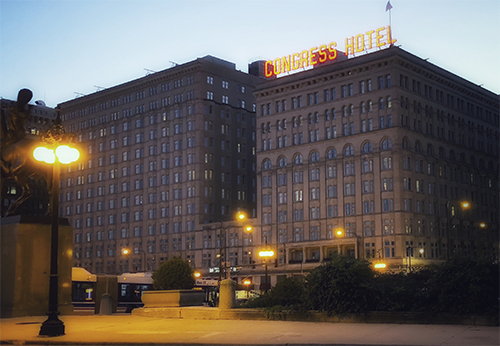
Built to cater to the multitude of visitors to The World’s Columbian Exposition of 1893, the Congress Plaza Hotel on South Michigan Avenue boasts a haunted and tortuous past, from its Tiffany-twisted lobby where America’s first documented serial killer, H. H. Holmes, is thought to have prowled for his next victim, to the Czech woman who hurled herself and her two small children from a 12th story window promising that they’d see their father soon. The one-legged “hobo,” dubbed Peg Leg Johnny, is rumored to have been killed in the hotel’s basement and is now the resident poltergeist scaring the dickens out of the unsuspecting guests of the South Tower. And several rooms are considered so haunted that one, Room 441, which is said to be visited by a violent spirit who shakes the bed and hurls objects at residents, requires a special request to stay there. The other, on the 12th floor of the North Wing, is sealed shut, permanently. Women whisper and men hum to guests in the Florentine Room. There are even phantom gunshots and the piano plays by itself. Ask the hotel staff to see the Gold Room, a popular place for a wedding. Don’t be surprised, however, if not all of your party end up on any photo you take in it, as people tend to disappear mysteriously from view.
Country House
241 W. 55th St., Clarendon Hills
Situated in Clarendon Hills, an idyllic, family-friendly suburb southwest of Chicago, Country House is a favorite haunt for locals to get a juicy burger and a cold brew. But the building, built as a tavern and roadhouse in 1922, turned the corner toward the paranormal around 1958 and never looked back. At the time, a beautiful blond woman is rumored to have been having an affair with the bartender. Spurned by her lover, one day the woman sped off in her car and careened into a tree a half mile down the road, dying on impact. A 1970s remodel of the building structure is thought to have released her restless spirit and now patrons report seeing her ghostly, disembodied image beckoning to them seductively from an empty storeroom window in the attic. Employees have witnessed plates levitate off their stacks before crashing to the floor. And the jukebox is heard playing a ’50s tune that is not carried on any of the 45s. Owners have employed mediums to discern what causes the ghostly phenomena; paranormal researchers have recorded subsonic sounds using parabolic microphones and have even used infrared photography to capture images of the legendary “Lady in Blue.”
The Site of the Eastland Disaster, later Harpo Studios
Chicago River (walk) between Clark and LaSalle streets
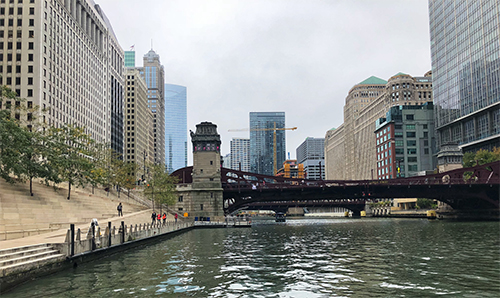
America’s worst maritime disaster on record (and one of the least talked about) holds the dubious honor of having claimed more lives than the Great Chicago Fire — 844 souls and 22 whole families. On July 24, 1915, the SS Eastland was docked at the Clark and LaSalle Street Bridge waiting to take employees of Western Electric Company to a picnic in Michigan City, Indiana. More than 3,200 passengers boarded the ship built for no more than 2,572. Within 15 minutes the vessel tipped over, entombing passengers in its lower decks under pianos, tables, and other soon-to-be victims. The horrific scene to follow saw a “sea of churning bodies” as heavy 19th-century clothing and frantic survivors dragged each other to the bottom of the river in a desperate scramble for safety. Hundreds of bodies were taken to the 2nd Regiment Armory on West Washington Avenue, which, in the 1980s, reopened as Oprah Winfrey’s Harpo Studios. Employees claimed to have heard doors slamming without reason, phantom old-time music, unexplained footsteps, disembodied children’s voices, sobbing, and terrifying screams for help. The apparition, aka “The Grey Lady,” presumed to be one of the mothers who lost her children and her life on the Chicago River, is reported to have been caught on security cameras. The location of the Eastland Disaster is marked by a memorial plaque that hangs between Clark and LaSalle streets and, to this day, strollers along Chicago’s River Walk at night claim to hear moans and blood-curdling screams emanating from the Clark Street Bridge.
Green Mill Cocktail Lounge
4802 N. Broadway St., Chicago

If you take Lake Shore Drive north of the city and get off on Lawrence Avenue, in a few short blocks you’ll run smack dab into the legendary Green Mill Cocktail Lounge and jazz club in Chicago’s Uptown neighborhood. Opened first as Pop Morse’s Roadhouse, the name was changed to the Green Mill Gardens some years later to reflect the verdant land on which it existed until the 1920s. When Prohibition became the law of the land, the saloon fell into the hands of notorious gangster Jack “Machine Gun” McGurn, one of Al Capone’s top lieutenants. Dripping in mob money and protection, the joint soon became one of the most profitable speakeasies in town. A network of underground tunnels provided safe passage to smuggle hooch in and the errant dead body out while musicians belted and banged out jazz tunes on its main stage. Accessed through a hatch behind the bar, the tunnels ran underneath Broadway to an adjacent building offering Capone a quick getaway from “the fuzz.” To this day, a candle burns nightly on the makeshift altar behind the ornate art deco bar in homage to Capone and the bloody gangland legacy. Patrons can still sit in his favorite booth at the short end of the ingot; its location affording clear views of both the front and back entrances should a speedy exit be warranted. Now mostly sealed up, the tunnels serve mainly as storage. Over the years, objects inside there are said to move mysteriously from where they are first placed, employees have heard unexplained noises, felt cold spots, and, those who have had the unenviable task of opening up in the mornings, swear they’ve heard the ivories tinkling when the joint is completely empty, no doubt offering up a requiem for the dead.
Hooters on Wells Street
660 N. Wells St., Chicago
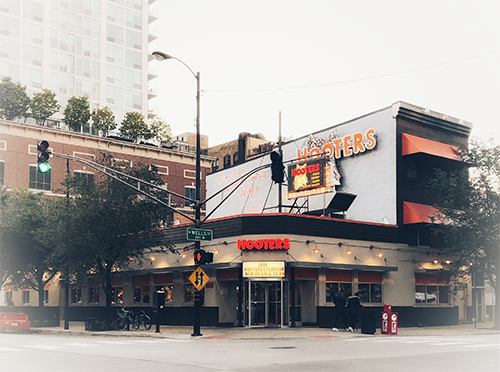
The restaurant chain known today for its, er, awesome wings of course, was once a storage place for cadavers. Yup. In the late 1800s, as the study of medicine was moving into the modern age, the call for human specimens on which to learn anatomy was booming. Resurrectionists, now called grave robbers, moved hundreds, perhaps thousands of bodies through the building that now boasts the popular eatery. Patrons and staff report seeing specters of two different male and a female ghost, all dressed in 19th-century garb and that disappear when they are approached. Temperatures are said to drop dramatically in random places throughout the building for no apparent reason. Objects fall off tables or shelves without anyone touching them, and phantom footsteps sound in areas where no one is walking. Battery-powered electronics seem to die more quickly, as if the building is draining power, while strange orbs appear and disappear on a whim and the jukebox turns itself on at will. So next time you go to the Wells Street Hooters, try taking your eyes off the delectable edibles and check out the ghostly offerings, if you dare.
Jane Addams Hull House Museum
800 S. Halsted St., UIC campus, Chicago
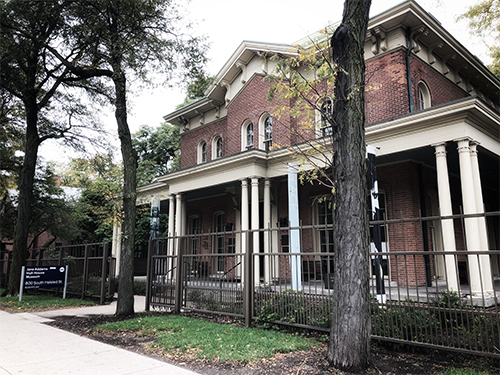
Founded in 1889 by Jane Addams and Ellen Gates Starr as a society to aid European immigrants of Chicago’s West Side, Hull House was considered a refuge for the underprivileged community. So when a local, self-proclaimed atheist fathered a deformed child (purportedly born with scaly skin, short horns, and a diminutive tail), rumors abounded that the baby was being given shelter at the House, too. Streams of visitors to see “The Devil Baby,” who most likely suffered from some sort of skin disorder not fully understood by turn-of-the-century medicine, disrupted all activity to the home for six weeks. From there, its legacy flowed into infamy. It is believed that Addams did try to care for the child, even attempted a failed exorcism, and eventually kept the child in the attic. These rumors are further bolstered by those who have claimed to see the face of a deformed child staring back at them from the attic window as they passed by. University of Illinois at Chicago took over most of the area, with only the main house now remaining of the 13-building compound once operated by the society. Be sure to look up into the attic windows next time you’re visiting UIC campus.
Site of the St. Valentine’s Day Massacre
2122 N. Clark St., Chicago
One of the most ghastly massacres in Chicago’s storied gangland history happened on Feb. 14, 1929, inside a warehouse garage, a stone’s throw from the petting zoo in Lincoln Park Zoo. Dubbed the St. Valentine’s Day Massacre, the gruesome hit cemented Alphonse “Scarface” Capone’s legacy as the most notorious mob boss of his day when four of his men took out seven rival gang members of his arch enemy, George “Bugs” Moran. The only survivor of the rat-tat-tat of the Tommy Guns was a dog named Highball who had accompanied his ill-fated owner to the bloody Valentine. To this day, the edges of the one-story brick structure can still be seen as a black outline on the adjoining building, now a nursing home’s front lawn. The itinerant passerby will occasionally report hearing violent screams emanating from the empty lot. And, if you happen to walk your dog by it, don’t be surprised if Fido suddenly cowers or growls at seemingly nothing. Highball is rumored to still be prowling around looking for his long-dead master.
Resurrection Cemetery
Resurrection Cemetery, 7201 Archer Road, Justice, Illinois
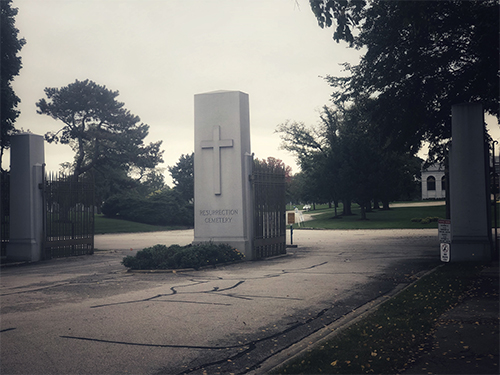
Resurrection Mary is part of Chicago’s disappearing hitchhiker lore, which casts the lonely 34-mile stretch that is Archer Avenue in rural Justice, 30 minutes outside of Chicago, as the most haunted roadway in Illinois. The story dates back to 1939 when a young southsider named Jerry Palus danced the evening away with a beautiful blond woman named Mary. After the dance, he escorted his date home and, though Mary had said she lived in town, she insisted on being driven down Archer Avenue. As they passed Resurrection Cemetery, Mary became agitated and said this is where she needed to get out. Jerry tried to accompany her but she stopped him with the words, “Where I’m going, you can’t follow.” The next day Jerry called on the residence Mary had told him was hers only to find that there had, indeed, lived a girl named Mary there but that she had died four years prior in a car crash. Sightings of Mary have been frequent over the years; many involving motorists who believe they’ve struck a young woman just outside the cemetery gates but who disappears when they stop to check. Travelers report picking up a hitchhiker on Archer who vanishes as they near the cemetery. And an irate cabbie once stormed into Chet’s Melody Lounge, across from Resurrection, to inquire where the young woman was he’d just dropped off as had stiffed him for the fare. After checking around the lounge, no such woman could be found. To this day, Chet’s leaves a Bloody Mary at the end of the bar, awaiting the return of their celebrity patron.
 Erstwhile columnist/photographer for the Daily Herald and currently 22nd Century Media, for the past 12 years Lee A. Litas has likewise been a dining and trend columnist and photographer for Pioneer Press, first under the Chicago Sun-Times and now under the Chicago Tribune umbrellas. Hailing from a half-Greek/half-Russian family where “filoxenia” was the way of life, Litas now makes it her business to find the juiciest morsels, both newsy and edible, wherever she travels. Graduate of The American Graduate School of International Management-Thunderbird and Indiana University’s Ernie Pyle School of Journalism; polyglot, all-around gadabout, and Argentine tango dancer — not all at the same time, mostly.
Erstwhile columnist/photographer for the Daily Herald and currently 22nd Century Media, for the past 12 years Lee A. Litas has likewise been a dining and trend columnist and photographer for Pioneer Press, first under the Chicago Sun-Times and now under the Chicago Tribune umbrellas. Hailing from a half-Greek/half-Russian family where “filoxenia” was the way of life, Litas now makes it her business to find the juiciest morsels, both newsy and edible, wherever she travels. Graduate of The American Graduate School of International Management-Thunderbird and Indiana University’s Ernie Pyle School of Journalism; polyglot, all-around gadabout, and Argentine tango dancer — not all at the same time, mostly.
